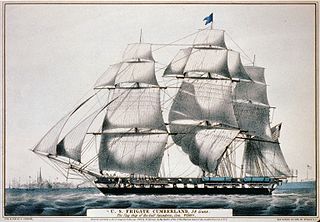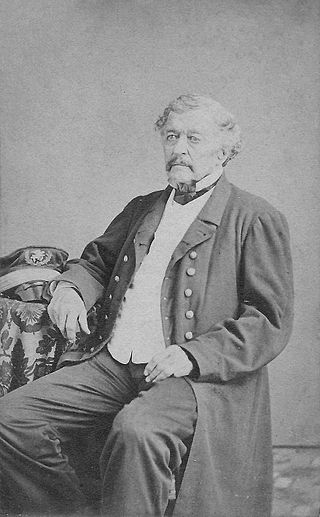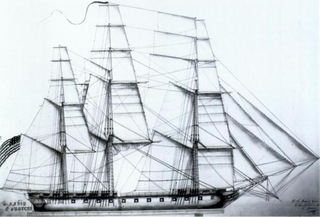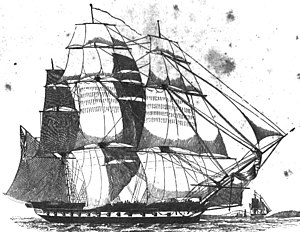
USS United States was a wooden-hulled, three-masted heavy frigate of the United States Navy and the first of the six original frigates authorized for construction by the Naval Act of 1794. The name "United States" was among ten names submitted to President George Washington by Secretary of War Timothy Pickering in March of 1795 for the frigates that were to be constructed. Joshua Humphreys designed the frigates to be the young Navy's capital ships, and so United States and her sisters were larger and more heavily armed and built than typical frigates of the period. She was built at Humphrey's shipyard in Philadelphia, Pennsylvania and launched on 10 May 1797 and immediately began duties with the newly formed United States Navy protecting American merchant shipping during the Quasi-War with France.

The second USS Ohio was a ship of the line of the United States Navy, rated at 74 guns, although her total number of guns was 104. She was designed by Henry Eckford, laid down at Brooklyn Navy Yard in 1817, and launched on 30 May 1820. She went into ordinary and in the ensuing years decayed badly. Refitted for service in 1838, Ohio sailed on 16 October 1838 to join the Mediterranean Squadron under Commodore Isaac Hull. Acting as flagship for two years, she protected commerce and suppressed the slave trade off the African coast. Ohio proved to have excellent performance under sail, repeatedly making more than 12 kn. One of her officers stated, "I never supposed such a ship could be built—a ship possessing in so great a degree all the qualifications of a perfect vessel." In 1840, Ohio returned to Boston, where she again went into ordinary. From 1841 to 1846, Ohio served as receiving ship.

The Battle of Monterey, at Monterey, California, occurred on 7 July 1846, during the Mexican–American War. The United States captured the town unopposed.

The first USS Cumberland was a 50-gun sailing frigate of the United States Navy. She was the first ship sunk by the ironclad CSS Virginia.

Jacob Zeilin was the United States Marine Corps' first non-brevet flag officer. He served as the seventh commandant of the United States Marine Corps, from 1864 to 1876.

USS Dale was a sloop-of-war in the United States Navy commissioned on 11 December 1839. Dale was involved in the Mexican–American War, the American Civil War, operations along Africa to suppress slave trade, and was used by the U.S. Revenue Cutter Service and later the U.S. Coast Guard, among other activities. Dale was placed into ordinary numerous times.

Thomas ap Catesby Jones was an American naval officer who served during the War of 1812 and the Mexican–American War.

The second USS Macedonian, was a three-masted, wooden-hulled sailing frigate of the US Navy, carrying 36 guns. Rebuilt from the keel of the first Macedonian at Gosport Navy Yard, Portsmouth, Virginia beginning in 1832, the new Macedonian was launched and placed in service in 1836, with Captain Thomas ap Catesby Jones in command.

Commodore Josiah Tattnall was a United States Navy officer during the War of 1812, the Second Barbary War and the Mexican–American War. He later served in the Confederate States Navy during the American Civil War.

The Pacific Squadron of the United States Navy, established c. 1821 and disbanded in 1907, was a naval squadron stationed in the Pacific Ocean in the 19th and early 20th centuries.

The second USS Cyane was a sloop-of-war in the United States Navy during the Mexican–American War.

William Branford Shubrick was an officer in the United States Navy. His active-duty career extended from 1806 to 1861, including service in the War of 1812 and the Mexican–American War; he was placed on the retired list in the early months of the Civil War.

Commodore Lawrence Kearny was an officer in the United States Navy during the early nineteenth century. In the early 1840s he began negotiations with China which opened that country to U.S. trade and pointed the way toward the American Open Door Policy a half century later. He was Mayor of Perth Amboy, New Jersey in 1848.

The California Battalion was formed during the Mexican–American War (1846–1848) in present-day California, United States. It was led by U.S. Army Brevet Lieutenant Colonel John C. Frémont and composed of his cartographers, scouts and hunters and the California Volunteer Militia formed after the Bear Flag Revolt. The battalion's formation was officially authorized by Commodore Robert F. Stockton, commanding officer of the U.S. Navy Pacific Squadron.

The Pacific Coast Campaign refers to United States naval operations against targets along Mexico's Pacific Coast during the Mexican–American War. It excludes engagements of the California Campaign in areas of The Californias north of the Baja California Peninsula. The objective of the campaign was to secure the Baja Peninsula of Mexico, and to blockade/capture west-coast ports of Mexico—especially Mazatlan, a major port-of-entry for imported supplies. The resistance of Mexican forces to the north in the Los Angeles area and the lack of ships, soldiers and logistical support prevented an early occupation of the peninsula and the west-coast Mexican seaports. The U.S. Navy attempted blockades of the ports three times before being able to successfully blockade and/or occupy them.

The Conquest of California, also known as the Conquest of Alta California or the California Campaign, was a military campaign during the Mexican–American War carried out by the United States in Alta California, then part of Mexico, lasting from 1846 to 1847, and ending with signing of the Treaty of Cahuenga by military leaders from both the Californios and Americans.

The West Indies Squadron, or the West Indies Station, was a United States Navy squadron that operated in the West Indies in the early nineteenth century. It was formed due to the need to suppress piracy in the Caribbean Sea, the Antilles and the Gulf of Mexico region of the Atlantic Ocean. This unit later engaged in the Second Seminole War until being combined with the Home Squadron in 1842. From 1822 to 1826 the squadron was based out of Saint Thomas Island until the Pensacola Naval Yard was constructed.
USS Petrita was a steamer that served in the United States Navy from 1846 to 1848. She saw service in the Mexican War.

The Battle of Yerba Buena was an engagement during the Mexican–American War, during which the U.S. Navy captured and occupied the town of Yerba Buena, California, without firing a shot.

El Castillo de Monterey was a fortification in Monterey, California, founded in 1792 by the Spanish Empire. The fort was constructed to protect the Monterey port and the Presidio of Monterey from invaders. The site was officially listed on the National Register of Historic Places on November 23, 1971.



















